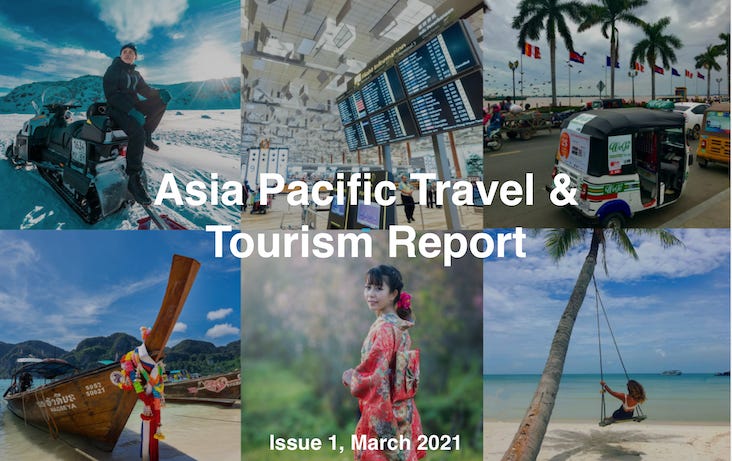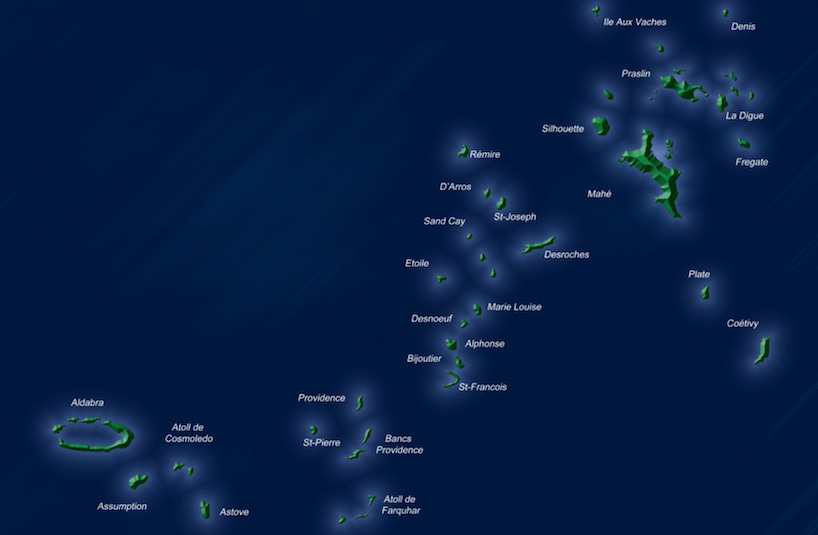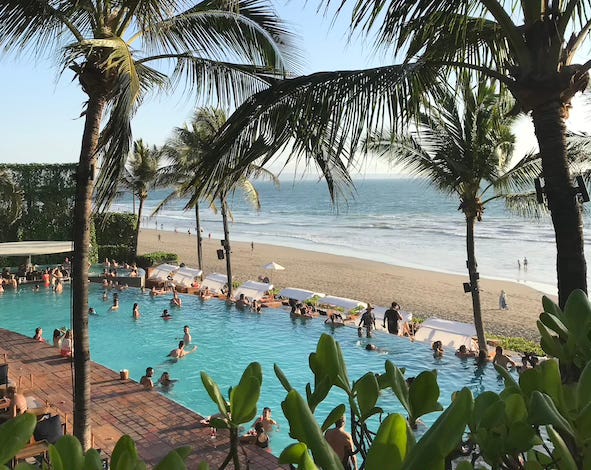Asia Travel Re:Set #34 - Asia Pacific Travel & Tourism Report, March 2021
The hottest topics of the month, from vaccine diplomacy and airline bankruptcies to rural tourism and, of course, travel bubbles!
Hello. Welcome to the first monthly Asia Pacific Travel & Tourism Report…
I’m delighted to team up with two brilliant travel analysts, Dr Jaeyeon Choe and Michelle Dy, to create this new report.
On the final Sunday of each month, we’ll review the top talking points, plus developments that drifted beneath the radar.
Countries featured in Issue 1 include China, Cambodia, Indonesia, Malaysia, Philippines, Seychelles, Thailand and South Korea.
Hot topics range from vaccine diplomacy, digital currencies and cruise port sales to airline bankruptcies, rural tourism and travel bubbles!
If you like what you read, please share with a friend or colleague - either by forwarding the email or using the button below. The power of sharing is underrated.
Thanks for being on board,
Gary
15 Travel Developments That Defined March 2021
Might Seychelles Become the New Maldives?
India has added Seychelles to a growing list of countries with which it has air bubbles.
This comes as, from 25 March, Seychelles officially reopened its borders to all visitors (except those from South Africa) irrespective of their vaccination status.
Visitors only need to present a negative PCR test taken 72 hours prior to departure. There will be no quarantine or restriction on movement upon entry into the country.
In 2020, India was the largest source market for the tourism industry in Maldives.
With a new air bubble between Seychelles and India now open, aligned with a current shortage of island getaway vacation options, we might see a similar Indian tourism boom in Seychelles in the next few months.
From Maldives & Seychelles to… Indonesia
South East Asia’s travel infrastructure build-out was well under way before the pandemic, and several new projects are now being announced.
Indonesia is viewed as a prime investment destination due to its vast size, the largest population in ASEAN - and its potential for domestic and inbound travel.
While Indonesia’s 5 ‘Super Priority’ destinations - Borobudur, Lake Toba, Mandalika, Labuan Bajo and Likupang - take precedence, Asia’s largest archipelago offers myriad untapped opportunities. And investors are signing up.
This month, Murban Energy from the UAE - which invests in resorts in Seychelles and Maldives - announced a new USD300-500 million “luxury resort” in Aceh Singkil in northwest Sumatra - incorporating small offshore islands.
Expect similar deals to be unveiled in the coming months.
Why Fewer Airline Bankruptcies than Expected?
Last year, pundits predicted a doomsday scenario for airlines. In March 2020, just as COVID-19 started to ravage the world, a noted aviation consultant said: “By the end of May, most airlines will be bankrupt.”
Fast-forward to today where, apart from the notable closures of NokScoot and AirAsia Japan, and the integration of Cathay Dragon into Cathay Pacific and HK Express, most airlines have survived and are holding on. For now.
Some even found the time (and resources) to establish new airlines, like Wizz Air Abu Dhabi (UAE) and Vietravel Airlines (Vietnam), plus a few more across the globe.
While some analysts credit this phenomena to the ability of certain airlines to raise liquidity and secure government financing, there is no guarantee that the money tap will keep flowing as the pandemic drags on.
Meanwhile, more efficient financial activities like mergers and acquisitions (M&As) remain restricted to domestic markets - such as the acquisition of Asiana Airlines by Korean Air. This is because of archaic foreign ownership and control restrictions in most jurisdictions that still render cross-border M&A activities impracticable.
Rethinking the Money Model in Cambodia
Central Bank Digital Currencies (CBDCs) are hot news because they will transform the way consumers perceive and use money at home and abroad.
China’s upcoming Digital Yuan is the hot pick because it will speed up the RMB’s internationalisation. China is also planning a cross-border pilot with Thailand and the UAE.
An interesting, smaller scale CBDC is Bakong in Cambodia. Launched in October 2020, Bakong uses a Japanese blockchain application to make mobile payments faster and easier.
Before Bakong, Cambodia’s banking infrastructure was fragmented and had to balance the national currency, Riel, with widespread dollarisation. In March, Bakong counted 5.6 million users, and it may presage further innovations.
“The advantage of being a small country is we can introduce new technologies into the system without disturbing what we already have,” says Serey Chea, Director General of the National Bank of Cambodia.
One to watch!
What’s the Future for Mass Tourism?
When tourism ministers talk about recovery of the tourism industry it increasingly involves attracting more “quality” and “high-value” tourists. We’ve seen more talk of this kind over the past month.
Empty beaches and quiet streets are making authorities rethink their previous strategy of enticing as many tourists as they can to justify setting higher arrival targets year-after-year. From here, more won’t be better as ecological factors gain extra traction.
This development is welcome since societies must do more to ensure that future generations can also enjoy the planet’s beautiful landscapes and natural reserves.
However, if “quality” tourism means expensive get-aways for elite travellers, will the world get smaller again because fewer people will be able to afford to see it?
Issue 2 will be published on Sunday 25 April — tell your friends and colleagues!
Cruise Port Reshuffle in Malaysia
Financially troubled Bousted Holdings, whose interests include Royale Chulan Hotels, has cut its cruise port losses. It will sell its stake in Port Klang Cruise Port (aka Bousted Cruise Centre) - “one of the few maritime gateways into Malaysia” - to a joint venture by rivals Westport and Northport for RM230 million.
This is a big write down from the RM310 million it paid in 2014, plus subsequent terminal investment.
Despite growth in Malaysia’s cruise sector in recent (pre-pandemic) years, Bousted still reported losses.
The reason for selling (at a heavy loss) now? No surprise. Malaysia’s borders have been closed since 18 March 2020, and the cruise sector is inactive.
"As the recovery of the cruise industry is anticipated to be protracted, Bousted Cruise Centre is expected to continue to be loss-making in the near term," said a statement.
Efforts to reboot domestic cruising are being made. Genting Cruise Lines plans to launch Penang-Langkawi and Straits of Malacca itineraries in May.
Should the Private Sector Procure Vaccines?
Are vaccines global public goods? If yes, should their distribution be left to governments?
These are two primary questions since news surfaced of a private hospital in Bangkok putting in orders for COVID-19 vaccines.
Apart from Thailand, other South East Asian countries, like the Philippines and Indonesia, have launched private procurement schemes. Malaysia has posed no objection against private parties negotiating with vaccine manufacturers.
In the strictest sense, vaccines are a private and finite good, since inoculating one person excludes a vaccine’s use for another. However, unlike other private goods, vaccines have a positive externality: the more people who get vaccinated, the better chances of preventing the pandemic enduring.
If we leave the distribution of this quasi-public good to the private sector, the capitalist temptation to sell to those willing to pay a premium may prove irresistible and exclude marginal groups.
To ensure that the most people are vaccinated in the shortest time possible, would it be better to let governments have a monopoly over access and distribution?
China Unveils its International Travel Health Certificate
Chinese President Xi Jinping probably didn’t expect much take up to his proposed global QR Code vaccine passport at the G20 summit last November. Geopolitics are shifting and Chinese technology solutions are proving unpopular in some parts.
However, as the world’s most coveted comeback market, China holds real leverage amid the swathe of digital travel health solutions unveiled/trialled in the past month.
China’s International Travel Health Certificate, which is integrated with the WeChat Mini Program ecosystem, is touted to help restart international travel later in the year.
Cross-border alignment of the various health pass systems being rolled out will remain a vexing political issue in the meantime.
"If only a minority of countries and regions agree to recognise digital health certificates, it won't work. The majority must be on board," said Zeng Guang, Chief Epidemiologist of China’s Center for Disease Control and Prevention.
The New Diplomacy Game in Town: Vaccines
In some South East Asian countries, concerns have been voiced about Chinese vaccines.
Compared to other approved vaccines, Sinovac counts a low efficacy rate of 50.4%; far below the 70% threshold recommended by the World Health Organisation (WHO).
As a gesture of goodwill, China is giving home-developed vaccines in 69 countries for free. This form of vaccine diplomacy is applauded in some nations, less so in others.
In the Philippines, for example, 95% of medical staff voiced opposition against the jab. It was eventually decided not to use the Chinese-donated jab for healthcare workers.
Perhaps for this reason, in what could be an effective geopolitical countermove, China announced this month that it will reopen non-tourism visa applications for visitors who have been fully inoculated with a Chinese vaccine and carry the digital certificate.
Inbound visitors will not be exempt from quarantine and testing, although the entry rules may become differentiated over time.
April will be an interesting month to see whether this strategy helps turn sceptical opinions in favour of Chinese vaccines - especially given global supply shortages.
Can ‘Rural Tourism’ Revitalise Off-Track Destinations?
Before COVID-19, tourism employment opportunities in Asia were concentrated on urban and coastal areas. Rural tourism, often unloved in destination marketing, has not generally achieved its far-reaching positive impact.
The pandemic may be a turning point. Governments are, belatedly, recognising the potential of tourism development in rural regions.
For example, the Tourism Authority of Thailand launched its rural tourism awards to enhance the quality of community-based tourism, provide marketing exposure and help upgrade facilities. China too, has been promoting the benefits of rural tourism.
The UNWTO notes: “Tourism in rural areas offers important opportunities for recovery as tourists look for less populated destinations and open-air experiences and activities.”
As countries seek a path out of border closures, a fairer geographic distribution of tourism benefits can advance the transition towards more resilient tourism economies.
Expect new facilities to open up in rural areas that are connected to cities.
The Old Bali Model is Gone! What's Next?
Pre-2020, Bali was a global case study in presenting itself as a high-profile tourism retreat - one that resonated with travellers from Indonesia’s big cities, across Asia and worldwide. Targeted incentives and campaigns appealed to a broad audience.
However, with almost a total collapse in international arrivals, there is a sense in the industry that tourists will not return to ‘normal’ any time soon.
The old Bali model appeared to offer commercial opportunities across the spectrum, supporting everything from beach vendors to backpacker hostels to 5-star resorts.
However, the pandemic showed how precarious the ‘mass’ tourism industry can be, and the lack of opportunities and health care for locals.
Hotels that replaced rice paddies sit derelict and clean, pristine beaches are polluted. Critical issues for Bali are social and environmental.
While talk ramped up in March about reopening, the next steps for the authorities should include education and health care, compensating for the loss of income - and creating specific income support programmes for families and businesses.
Will Wellness Tourism Kickstart a Recovery?
As the COVID-19 travel stasis drags on, mental health is a global issue. Asia Pacific is no exception.
In future, as people seek destinations and activities to assist their psychological and physical recovery, new opportunities for wellness tourism will emerge.
With vaccine programmes progressing in the US, UK, Canada, parts of Europe and the Middle East, some South East Asian countries plan to re-open (at least partially) in late 2021.
The Asian Development Bank (ADB) predicts that destinations which are prepared for wellness travel demand will recover faster from the economic fallout of the pandemic.
Tourists will likely want spacious, quiet and wellness equipped accommodations, where they can social distance while enjoying nature walks, yoga and mindful practices.
Expect DMOs to utilise well-being and spiritual components in their marketing as they re-orient towards healthy activities.
Domestic Tourism: Can it Become Sexy Again?
Whilst Asian governments have pleadingly encouraged domestic travel through national campaigns, they recognise that home-grown spending cannot replace foreign currency earnings.
Domestic tourism strategies seem to have reached a natural limit.
Thailand suspended its travel subsidy programme to investigate allegations of corruption. Japan placed its Go To Travel initiative on ice. Internal travel restrictions still apply in countries like the Philippines and Malaysia.
However, South Korea has been relatively successful in creating and supporting demand for domestic tourism using technology and well-managed hygiene practices.
To optimise domestic tourism, mining travel data and researching tourist behaviours and consumption patterns are vital. This can help curate creative tourism concepts - such as the successful one-month stay and purple islands initiatives.
Expect more countries to take another look at domestic travel in the coming months.
Travel Bubbles 2.0.: Taiwan Makes a Move
Taiwan is one of the few countries to effectively suppress the spread of COVID-19. For this reason, travel is a tricky subject to address. Containment was supported by banning inbound/outbound travel.
Next week, Taiwan will commence its first travel bubble with Palau, on April 1. The pilot project is small-scale. Numerous restrictions are in place.
Only 110 travellers can take one of the two 3.5-hour flights per week to the Micronesia region in the western Pacific Ocean.
While this travel bubble seems like a test, how sustainable are travel bubbles - and can they actually be scaled up once in motion?
Rebuilding Resilience to Future Shocks
“Scarring” describes the deep, below-skin impact of the pandemic on national economies.
“These scarring effects are likely to be larger in countries that are highly dependent on tourism and other services that require in-person contact,” notes the Policy Advice to Asia in the COVID-19 Era paper, published in March by the International Monetary Fund (IMF).
Countries in Asia Pacific, it adds, provided “significant fiscal and monetary policy support” to cushion the impact of the pandemic on their economies.
This may result in some nations “contending with debt burdens that are possibly too large to manage.”
The IMF posits a shift to “eco-sustainable tourism services with lower density, higher value-added and greater digitalisation to allow countries to reduce the health risks potentially associated with mass travel, foster a greener recovery and diversify their economies to increase their resilience to future shocks.”
If only it were that simple.
About the Team
Originally from South Korea, Dr Jaeyeon Choe is a Senior Academic at Bournemouth University in the UK and a consultant specialising in sustainable tourism development in South East Asia, sustainable community development and wellness/spiritual tourism.
Based in Malaysia, Michelle Dy is a regulatory lawyer with extensive experience in policy research and public affairs across Asia-Pacific. She is also a published author of several academic journal papers and book chapters on cutting-edge issues in aviation.
Based in Malaysia, Gary Bowerman is Director of Check-in Asia, co-host of The South East Asia Travel Show and author of The New Chinese Traveler. Founder of Asia Travel Re:Set, he is a media commentator and speaker on Asian travel economics and trends.
And, that’s a wrap. The Asia Pacific Travel & Tourism Report will return on 25 April.
Until next Sunday, find me on Twitter, LinkedIn and the Asia Travel Re:Set website.
Have a great week,
Gary










